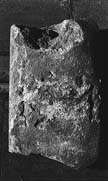Select a site alphabetically from the choices shown in the box below. Alternatively, browse sculptural examples using the Forward/Back buttons.
Chapters for this volume, along with copies of original in-text images, are available here.
Object type: Fragment of cross-shaft
Measurements: L. 47 cm (18.5 in); W. 27 > 26 cm (10.6 > 10.2 in); D. 15 cm (5.9 in)
Stone type: Stone: [Upper Lincolnshire Limestone, Inferior Oolite Group, ?of local origin]
Plate numbers in printed volume: 439–42
Corpus volume reference: Vol 5 p. Vol 5 p. 322
(There may be more views or larger images available for this item. Click on the thumbnail image to view.)
Loose at west end of nave
There is no clear evidence for its discovery, but this might, like no. 1 (above), have come to light during the restoration of 1898–99 and have been amongst the 'interesting features found and preserved' ((—) 1899–1900, xlviii–ix).
Poor. The fragment is very greatly abraded.
A small section from the central part of a tapered cross-shaft. The shaft has tightly wrought cable-moulded angles, but is otherwise undecorated on the surviving faces. The remains of a dowel hole survive in the head end, by which the next section of the shaft or the cross-head would have been attached. Both ends of the fragment have been extensively reworked during periods of reuse.
Appendix G item (the continuing tradition).
This fragment must represent a similar shaft to Castle Bytham 2, but its geometry suggests that it was considerably shorter. It may have had sparse decoration on its faces, as on no. 2, or may have been entirely undecorated. The style of the cable moulding is similar to no. 2 and this probably suggests a similar date.
Pevsner et al. 1989, 215



